The Beauty and Serenity of Sakya Monastery: Your Next Travel Destination
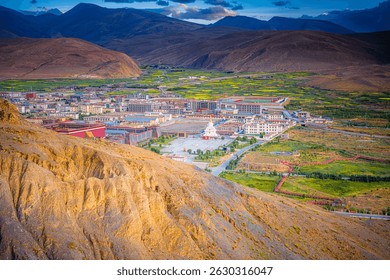
An Essential Guide to Visiting Sakya Monastery
Nestled in the breathtaking landscapes of Tibet, Sakya Monastery stands as a testament to the region’s rich spiritual heritage and vibrant culture. Founded in 1073 by the visionary Khön Könchok Gyalpo, this ancient sanctuary is not only the principal seat of the Sakya school of Tibetan Buddhism but also a beacon of historical significance, often referred to as the “Second Dunhuang” for its extensive collection of ancient scriptures and murals.
As you approach the monastery, the striking architecture—characterized by its unique gray, red, and white striped walls—invites you to explore its storied past. Each hue embodies the core principles of Tibetan Buddhism: wisdom, compassion, and strength. Inside, the monastery reveals a treasure trove of knowledge, with over 40,000 volumes in its vast library and intricately adorned halls filled with sacred art and historical artifacts.
Whether you are a spiritual seeker yearning for enlightenment, an avid history buff eager to delve into the past, or simply a curious traveler, Sakya Monastery promises an unforgettable journey into the heart of Tibetan culture. With its serene atmosphere and profound teachings, this sacred space calls out to visitors from around the globe, inviting you to immerse yourself in the timeless wisdom and beauty that define this remarkable site. Prepare to be inspired and transformed by the spiritual ambiance that pervades Sakya Monastery, where every corner holds a story and every moment is a chance to connect with something greater.
In This Guide
- An Essential Guide to Visiting Sakya Monastery
- The Rich History and Legends of Sakya Monastery
- Main Highlights: What You Absolutely Can’t Miss
- Planning Your Visit: A Practical Guide
- Tickets: Prices, Booking, and Tips
- How to Get There: A Complete Transportation Guide
- Local Cuisine and Accommodation Nearby
- Frequently Asked Questions
- Final Thoughts on Your Trip
The Rich History and Legends of Sakya Monastery
Sakya Monastery, a vital cornerstone of Tibetan Buddhism, is steeped in rich history and legendary tales that weave together the spiritual and cultural fabric of Tibet. Founded in 1073 by the revered Khön Könchok Gyalpo, the monastery has served as the principal seat of the Sakya school, one of the four main traditions of Tibetan Buddhism. The name “Sakya,” meaning “pale earth,” reflects the distinctive gray soil of the region, symbolizing the monastery’s deep-rooted connection to the land.
Throughout the centuries, Sakya Monastery has evolved from a humble center of learning into a powerful religious and political institution. Its prominence surged during the 13th century, thanks to strategic alliances with the Mongol Empire. Notably, Sakya Pandita, a luminary scholar, and his nephew Phagpa played crucial roles in establishing Buddhism as the state religion of the Yuan dynasty, thus elevating the Sakya lamas to positions of authority over Tibet. This era marked the apex of Sakya’s political influence, although it later faced challenges from rival schools such as the Gelug.
The monastery is divided into two main sections: the Northern Monastery, which largely lies in ruins, and the Southern Monastery, constructed in 1268. The Southern Monastery is particularly renowned for its robust fortress-like architecture, a fusion of Tibetan and Mongolian styles that evokes a sense of strength and stability. Its thick walls, adorned with gray, red, and white stripes, symbolize the three Buddha bodies: wisdom, compassion, and strength.
Visitors to Sakya Monastery are often enchanted by its architectural grandeur and the treasures it houses. The Great Sutra Hall stands as the spiritual heart of the complex, capable of accommodating thousands of monks for chanting. The hall’s intricately carved wooden beams, embellished with Buddhist symbols, reflect the artistry of Tibetan craftsmanship.
Among the monastery’s most significant features is its vast library, often referred to as the “Second Dunhuang.” This repository holds over 40,000 volumes of ancient scriptures, including sutras and tantras, many of which are written in gold ink on black paper. The library not only preserves Buddhist teachings but also encompasses works on diverse subjects such as astronomy, medicine, and philosophy, showcasing the breadth of knowledge cultivated within these walls.
Legends surrounding Sakya Monastery abound, enriching its narrative. One such tale recounts the arrival of sacred relics that were believed to bestow blessings upon the land and its people. The monastery’s rituals and festivals, particularly the vibrant Cham Dance Festival held in July, attract devotees and travelers alike, fostering a sense of community and spiritual connection.
As you wander through the monastery’s courtyards and prayer halls, you are transported back in time, enveloped in an atmosphere steeped in spirituality and history. The intricate murals, ancient manuscripts, and ceremonial objects tell stories of devotion and enlightenment, inviting visitors to partake in the enduring legacy of Tibetan Buddhism.
Sakya Monastery stands not just as a place of worship, but as a testament to the resilience of Tibetan culture and its profound spiritual heritage. Whether you are a seeker of knowledge, a curious traveler, or a pilgrimage enthusiast, the monastery beckons you to explore its rich history and timeless teachings, offering a unique glimpse into the heart of Tibetan Buddhism.
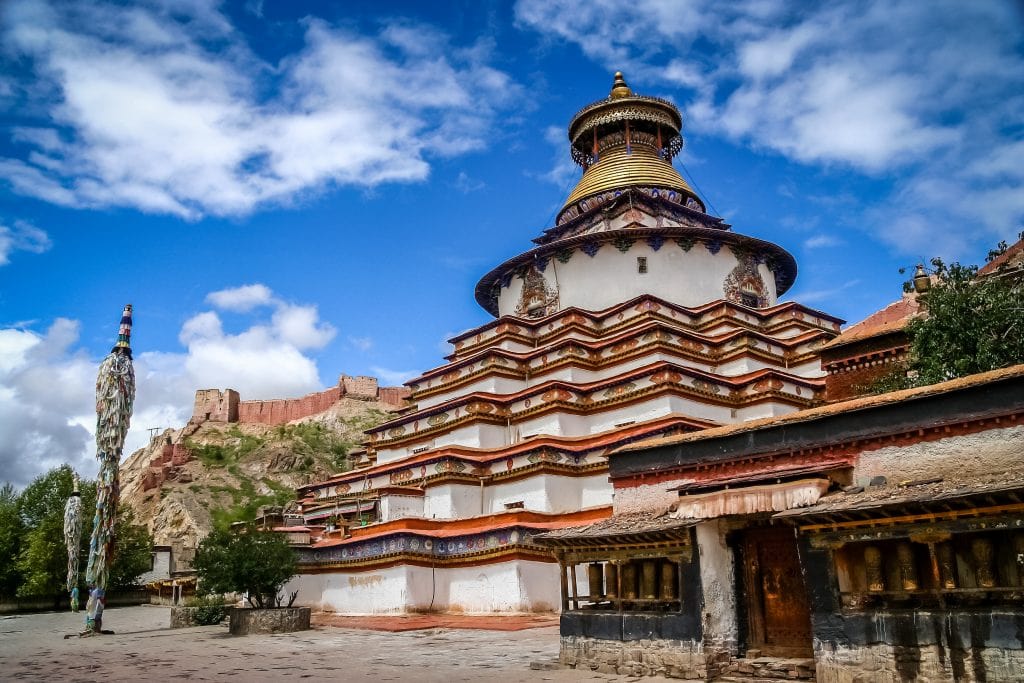
Sakya Monastery.
Main Highlights: What You Absolutely Can’t Miss
Sakya Monastery, a significant gem in Tibetan Buddhism, offers visitors an immersive experience enriched with history, spirituality, and breathtaking architecture. Here are the main highlights that you absolutely cannot miss during your visit:
1. The Sacred Lakhang Chenmo Hall
Step into the heart of Sakya Monastery by visiting the Lakhang Chenmo Hall, the main prayer hall that radiates serenity and spiritual energy. Adorned with intricate murals and vibrant decorations, this hall serves as a tranquil space for meditation and reflection. Marvel at the craftsmanship that embodies centuries of artistic and spiritual dedication.
2. The Unique Architectural Style
Unlike many Tibetan monasteries characterized by bright colors, Sakya Monastery features a striking palette of gray, red, and white, symbolizing the three Buddha bodies—wisdom, compassion, and strength. The monastery’s fortress-like structure not only showcases its historical significance but also its resilience against natural calamities. Take a moment to appreciate the thick walls and the harmonious blend of Tibetan and Mongolian architectural elements.
3. The Great Sutra Hall
Don’t miss the Great Sutra Hall, the spiritual nucleus of the monastery where thousands of monks can chant simultaneously. This vast hall is not only a sight to behold but is also a testament to the monastery’s role in preserving and promoting Buddhist teachings. The intricately carved wooden beams are adorned with symbolic motifs, enhancing the hall’s sacred atmosphere.
4. The Treasure Trove of the Sakya Library
Known as the “Second Dunhuang,” the Sakya Library is a highlight of the monastery that holds over 40,000 ancient scriptures. Explore this treasure trove filled with manuscripts written in gold ink on black paper, some dating back to the 13th century. The library’s collection encompasses various subjects, including astronomy, medicine, and philosophy, reflecting the rich intellectual heritage of Tibetan Buddhism.
5. The Historical Murals and Thangkas
As you wander through the monastery, take note of the numerous murals and thangkas that narrate Buddhist stories and depict revered figures. Many of these artworks date back to the Yuan dynasty, showcasing the artistic brilliance and historical significance of Sakya Monastery. Look closely at the details; each piece is a window into the rich tapestry of Tibetan culture and spirituality.
6. The Serene Courtyards and Chapels
Beyond the main structures, the courtyards and smaller chapels of Sakya Monastery offer a peaceful respite from the bustling world outside. These areas are perfect for quiet contemplation and prayer. Engage with the local monks and visitors, and soak in the spiritual ambiance that fills these sacred spaces.
7. Participate in the Cham Dance Festival
If your visit coincides with July, make sure to experience the Cham Dance Festival, a vibrant celebration characterized by traditional dances, music, and ritual performances. This festival is not only a feast for the eyes but also a unique opportunity to engage with the local culture and spirituality.
8. Explore the Surrounding Attractions
After immersing yourself in the monastery, consider visiting nearby sites such as Shalu Monastery or Natang Monastery. Each location offers distinct experiences and adds depth to your understanding of Tibetan Buddhism and culture.
Conclusion
Sakya Monastery is more than just a historical site; it is a living testament to Tibetan Buddhism’s rich heritage. Each corner of the monastery tells a story, and every prayer hall invites reflection. Make the most of your visit by engaging with the spiritual essence and cultural treasures that Sakya Monastery has to offer.

Sakya Monastery.
Planning Your Visit: A Practical Guide
Visiting Sakya Monastery offers an enriching experience steeped in spiritual significance and cultural heritage. Here’s everything you need to know to plan your visit to this remarkable site in Tibet.
Getting There
Sakya Monastery is located in Sakya County, approximately 160 kilometers southwest of Shigatse. The best way to reach the monastery is by taking a bus from Shigatse Station, with fares ranging from CNY 50-60 per person. Alternatively, you can opt to rent a car for greater flexibility and comfort.
Admission Details
- Opening Hours: The monastery is open daily from 9:00 AM to 6:30 PM.
- Admission Fee: Entry to the monastery costs CNY 50 per person.
Best Time to Visit
The ideal time to visit Sakya Monastery is during its vibrant religious festivals, particularly the Cham Dance Festival, which occurs in July. This colorful celebration lasts for about ten days and is an excellent opportunity to witness traditional dances and rituals while praying for happiness and good fortune.
What to See
Sakya Monastery is famed for its impressive architecture and extensive collection of Buddhist scriptures and artworks. As you explore the site, don’t miss these highlights:
- Lakhang Chenmo Hall: The main hall features intricate murals and vibrant decorations, providing a serene atmosphere for meditation.
- The Great Sutra Hall: This vast hall can accommodate thousands of monks and is adorned with beautifully carved wooden beams.
- The Buddha Hall: Home to exquisite statues of Sakyamuni Buddha, Manjusri Bodhisattva, and Guanyin Bodhisattva, crafted from precious materials.
- The Library: Known as the “Second Dunhuang,” this library holds over 40,000 ancient texts, representing a treasure trove of knowledge.
What to Expect
As you wander through the monastery’s halls, take in the unique architecture characterized by gray, red, and white stripes, symbolizing wisdom, compassion, and strength. The massive walls are designed to withstand natural disasters, and the atmosphere is filled with the rich history and spiritual essence of Tibetan Buddhism.
Nearby Attractions
While visiting Sakya Monastery, consider exploring nearby sites that add to the richness of your experience:
- Shalu Monastery: Known for its beautiful murals and architecture, this monastery is a short drive away.
- Rongbuk Monastery: Located closer to Everest Base Camp, this site offers stunning views and a unique experience.
- Rongpuk Glacier: A breathtaking natural wonder, perfect for those looking to explore the great outdoors.
Practical Tips
- Altitude Awareness: Sakya Monastery is situated at an altitude of 4,316 meters (14,150 feet). Ensure you acclimatize properly to avoid altitude sickness.
- Dress Appropriately: Respect the local customs by dressing modestly. Comfortable walking shoes are recommended as you explore the monastery grounds.
- Photography: Capture the stunning architecture and vibrant murals, but be mindful of areas where photography may be restricted.
Conclusion
A visit to Sakya Monastery is not just a journey to a historical site; it’s an immersion into the heart of Tibetan Buddhism and culture. Whether you are a spiritual seeker or a culture enthusiast, the monastery invites you to discover its timeless teachings and majestic beauty. Prepare for an unforgettable experience that will leave you with memories to cherish for a lifetime.
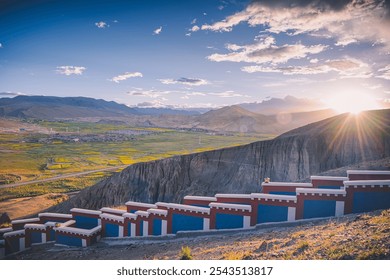
Sakya Monastery.
Tickets: Prices, Booking, and Tips
Visiting Sakya Monastery offers a profound glimpse into the spiritual heart of Tibetan Buddhism, and planning your visit involves a few key details regarding tickets, transportation, and tips for an enriching experience.
Admission Details
- Entry Fee: The admission price for the monastery is 50 CNY per person, making it a budget-friendly destination for travelers looking to immerse themselves in Tibetan culture and history.
- Opening Hours: Sakya Monastery welcomes visitors daily from 9:00 AM to 6:30 PM. It’s advisable to plan your visit within these hours to fully explore the site.
Getting There
- Transportation Options: Reaching Sakya Monastery is relatively straightforward. You can catch a bus from Shigatse Station for approximately 50-60 CNY per person. Alternatively, renting a car can offer more flexibility to explore the surrounding areas at your own pace.
Best Time to Visit
- One of the most vibrant times to experience the monastery is during the Cham Dance Festival, held in July for about ten days. This festival is a colorful celebration filled with traditional dances and rituals, creating a unique opportunity for visitors to engage with local culture.
Booking Tips
- Advance Booking: While entrance tickets can typically be purchased on-site, booking a guided tour in advance can enhance your experience, providing insightful context about the monastery’s rich history and spiritual significance.
- Group Tours: Consider joining a small group tour that includes Sakya Monastery as part of a broader itinerary. This often provides better access to knowledgeable guides and the chance to meet fellow travelers.
Insider Tips
- Dress Appropriately: As a place of worship, dress modestly and respectfully. Comfortable shoes are also recommended, as you’ll be walking through various halls and outdoor areas.
- Photography: Be mindful of where photography is permitted, as some areas may restrict taking pictures to preserve the sanctity of the space.
- Stay Hydrated: At an altitude of 4,316 meters, it’s essential to stay hydrated and take it easy to acclimatize.
By keeping these details in mind, your visit to Sakya Monastery will be both memorable and enriching, allowing you to delve deep into the spiritual and cultural tapestry of Tibetan Buddhism.
How to Get There: A Complete Transportation Guide
To embark on your journey to Sakya Monastery, nestled in the serene landscapes of Tibet, you’ll need to plan your transportation carefully. This guide will help you navigate the various options available to reach this significant spiritual landmark.
Getting to Sakya Monastery
- Starting Point: Shigatse
-
The nearest major city to Sakya Monastery is Shigatse, which is approximately 160 kilometers (about 100 miles) away. Shigatse is well-connected to Lhasa and other regions of Tibet, making it a convenient base for your travels.
-
Traveling from Lhasa to Shigatse
- By Bus: You can catch a bus from Lhasa to Shigatse. Buses depart frequently from the Lhasa Bus Station and the journey takes around 6-7 hours. Fares are typically between CNY 60-80.
- By Train: Alternatively, you can take a train from Lhasa to Shigatse, which offers stunning views of the Tibetan countryside. The train ride lasts about 4-5 hours, and tickets can be purchased in advance online or at the station.
-
By Private Car: For a more comfortable and personalized experience, consider hiring a private car or joining a tour group that offers transportation as part of the package. This option allows for flexibility in your itinerary and stops along the way.
-
From Shigatse to Sakya Monastery
- By Bus: Once in Shigatse, you can take a local bus to Sakya Monastery. Buses depart regularly from Shigatse Station and the fare ranges from CNY 50-60 per person. The bus ride takes about 2-3 hours and offers a glimpse of the beautiful Tibetan landscape.
- By Taxi or Ride-Hailing Service: If you prefer a direct route without the wait, taxis are available in Shigatse. The fare for a taxi ride to Sakya Monastery may vary, but expect to pay around CNY 200-250. Ride-hailing apps may also operate in this region, providing another option for convenience.
-
Car Rental: For those who wish to explore at their own pace, renting a car is a viable option. Ensure you have the necessary permits and a valid international driving license. Keep in mind that road conditions can vary, so be prepared for a bumpy ride.
-
Travel Tips
- Altitude Considerations: Sakya Monastery is situated at an altitude of 4,316 meters (14,150 feet). Allow yourself time to acclimatize to the altitude before making your way to the monastery to minimize the risk of altitude sickness.
- Best Time to Visit: The ideal time to visit Sakya Monastery is during the annual Cham Dance Festival in July, which lasts about ten days. This vibrant celebration attracts many visitors and offers a unique cultural experience.
-
Check Permit Requirements: As an international traveler, you will need a Tibet Travel Permit to enter Tibet. Ensure that all your travel documents are in order before your journey.
-
Final Steps
- After arriving at Sakya Monastery, you can explore its impressive architecture, rich history, and spiritual significance. Spend time in the tranquil surroundings as you immerse yourself in the beauty of Tibetan Buddhism.
With this comprehensive transportation guide, you are well-equipped to make your way to Sakya Monastery. Safe travels and enjoy your journey into the heart of Tibetan culture!
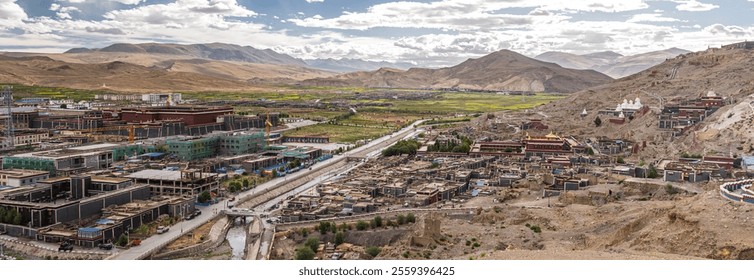
Sakya Monastery.
Local Cuisine and Accommodation Nearby
When visiting the sacred grounds of Sakya Monastery, immersing yourself in the local culture is essential, and this includes indulging in the delightful Tibetan cuisine and finding a comfortable place to rest after a day of exploration.
Culinary Delights Nearby
A trip to Tibet wouldn’t be complete without savoring its unique and flavorful dishes. Here are some recommended dining spots near Sakya Monastery:
-
Sakya Restaurant: Located just a short distance from the monastery, this cozy eatery offers traditional Tibetan dishes. Be sure to try their momo (steamed dumplings filled with meat or vegetables) and thukpa (noodle soup), which are both local favorites. The warm atmosphere and friendly staff make it a perfect place to recharge.
-
Gyantse Garden Restaurant: Situated in Gyantse, this restaurant serves a mix of Tibetan and Chinese cuisine. The yak meat dishes are especially popular, and the stunning views of the mountains make dining here a memorable experience.
-
Shigatse Grand Hotel Restaurant: If you find yourself in Shigatse, this hotel restaurant is a great option. They offer a wide variety of dishes, including Tibetan, Chinese, and Western fare. The ambiance is elegant, and it’s a great place to enjoy a hearty meal after a day spent at the monastery.
-
Local Street Stalls: For the adventurous eater, exploring local street stalls can yield delicious finds. Look for tingmo (steamed bread) and chang (barley beer) for an authentic taste of Tibetan street food.
Comfortable Stays
After a fulfilling day of exploring the monastery and its surroundings, you’ll want a cozy place to rest. Here are some nearby accommodations to consider:
-
Zangmu Hotel: Located in Sakya County, this hotel offers comfortable rooms with modern amenities. It’s an ideal base for exploring the monastery, and the staff is known for their hospitality and helpfulness.
-
Shigatse Hotel: A little further away in Shigatse, this hotel provides a comfortable stay with stunning views of the surrounding mountains. It’s a great option for those who wish to explore the region further while enjoying spacious rooms and a restaurant that serves local dishes.
-
Sakya Palace Hotel: Close to the monastery, this hotel offers a blend of traditional Tibetan architecture and modern comforts. Guests appreciate the serene environment and the opportunity to relax in a setting that reflects Tibetan culture.
-
Guesthouses: For a more intimate experience, consider staying in one of the local guesthouses. These often provide a closer connection to the local way of life and may offer homemade meals featuring traditional Tibetan cuisine.
Whether you’re enjoying a delicious meal or resting in a cozy accommodation, the local offerings near Sakya Monastery are sure to enhance your travel experience in this remarkable corner of Tibet.
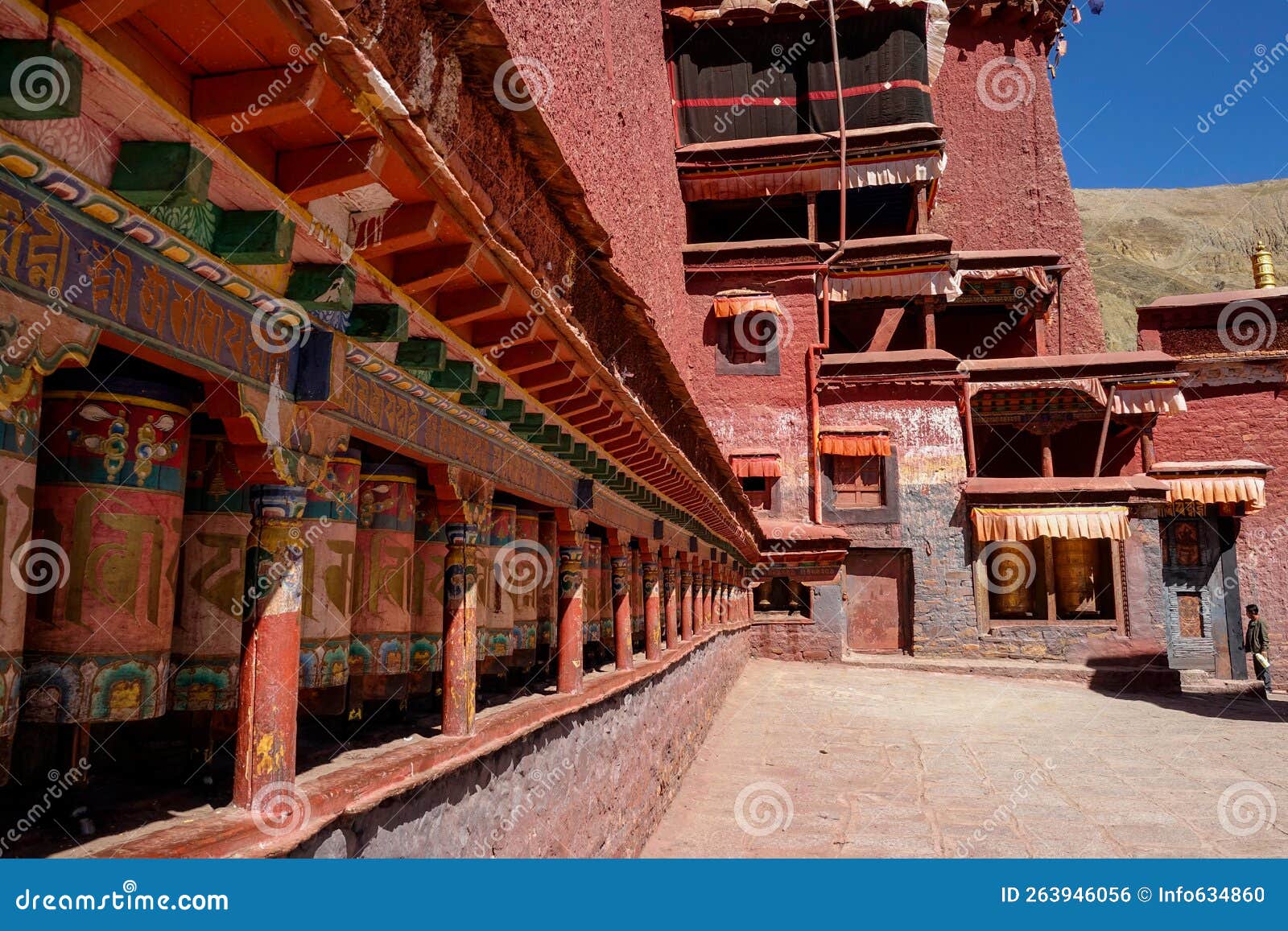
Sakya Monastery.
Frequently Asked Questions
Frequently Asked Questions about Sakya Monastery
-
What are the opening hours of Sakya Monastery?
Sakya Monastery is open daily from 9:00 AM to 6:30 PM. It’s advisable to arrive early to explore the serene surroundings and avoid larger crowds. -
How do I get to Sakya Monastery from Shigatse?
You can take a bus from Shigatse Station to Sakya Monastery, with tickets costing between CNY 50-60 per person. Alternatively, consider renting a car for a more convenient and flexible journey. -
Is there an admission fee to enter Sakya Monastery?
Yes, the admission fee for Sakya Monastery is CNY 50 per person. This fee helps maintain the monastery and its facilities. -
When is the best time to visit Sakya Monastery?
One of the most vibrant times to visit is during the Cham Dance Festival in July, which lasts about 10 days. This religious event offers a unique opportunity to witness traditional Tibetan performances and engage in spiritual activities. -
Are there any specific dress codes or conduct expectations for visitors?
Visitors are encouraged to dress modestly and respectfully. It is customary to remove your shoes before entering prayer halls and to maintain a quiet demeanor to honor the sacred environment. -
Can I take photographs inside the monastery?
Photography is generally permitted in the outer areas of the monastery, but discretion is advised when it comes to taking pictures inside prayer halls or of monks. Always ask for permission when in doubt. -
What should I know about the altitude of Sakya Monastery?
Sakya Monastery is situated at an altitude of 4,316 meters (14,152 feet). Travelers not accustomed to high altitudes may experience some symptoms of altitude sickness. It’s recommended to acclimate properly and stay hydrated. -
Are there any nearby attractions to visit after exploring Sakya Monastery?
Yes! Nearby attractions include Shalu Monastery, Rongbuk Monastery, and the stunning Rongpuk Glacier. These sites offer additional insights into Tibetan culture and breathtaking landscapes, making them perfect for a day of exploration.
Final Thoughts on Your Trip
As you reflect on your journey to Sakya Monastery, allow yourself to bask in the serenity and profound spirituality that this ancient site embodies. Nestled against the breathtaking backdrop of the Tibetan landscape, Sakya Monastery is not just a destination; it is a living testament to centuries of Buddhist tradition, scholarship, and artistry. The intricate murals, sacred relics, and the rich tapestry of history that envelop this monastery invite you to explore deeper into the essence of Tibetan culture.
Whether you wandered through the imposing halls of the Great Sutra Hall, marveled at the exquisite craftsmanship of the Buddha Hall, or contemplated the teachings of Buddhism amidst the tranquil courtyards, each moment spent here is a reminder of the sacred connection between humanity and the divine.
As you return home, carry with you the wisdom and tranquility that Sakya Monastery offers. Let it inspire you to seek peace in your own life and to cherish the beauty of diverse cultures and traditions. The journey may have ended, but the teachings and experiences from this remarkable monastery will remain with you, as enduring as the ancient scriptures housed within its revered walls. Embrace the spirit of Sakya, and may it guide you on your future adventures.